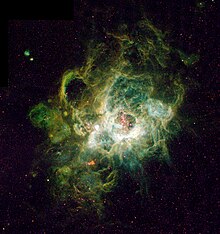Oblast HII

Oblast HII je mezihvězdný oblak složený z ionizovaného vodíku H+. Je to nejběžnější typ emisní mlhoviny. Vzniká ionizací neutrálních vodíku, nejčetnějšího prvku mezihvězdné hmoty. Takto ionizovaný vodík označujeme HII.
Většinou mladé, žhavé hvězdy produkují ultrafialové záření, to pak ionizuje plynné oblasti, které tyto hvězdy obklopují. V oblastech HII vzniká většina hvězd. Mezi nejznámější mlhoviny typu oblast HII patří Orlí mlhovina, mlhovina Rozeta, Carina a Mlhovina Tarantule.
Odkazy
Literatura
- EHLEROVÁ, Soňa. Vodík, základ galaxií. Astropis. 2024, roč. XXX, čís. 140, s. 34-35. ISSN 1211-0485.
Související články
Externí odkazy
 Obrázky, zvuky či videa k tématu oblast HII na Wikimedia Commons
Obrázky, zvuky či videa k tématu oblast HII na Wikimedia Commons
Média použitá na této stránce
This is a Hubble Space Telescope image (right) of a vast nebula called NGC 604, which lies in the neighboring spiral galaxy M33, located 2.7 million light-years away in the constellation Triangulum.
This is a site where new stars are being born in a spiral arm of the galaxy. Though such nebulae are common in galaxies, this one is particularly large, nearly 1,500 light-years across. The nebula is so vast it is easily seen in ground-based telescopic images (left).
At the heart of NGC 604 are over 200 hot stars, much more massive than our Sun (15 to 60 solar masses). They heat the gaseous walls of the nebula making the gas fluoresce. Their light also highlights the nebula's three-dimensional shape, like a lantern in a cavern. By studying the physical structure of a giant nebula, astronomers may determine how clusters of massive stars affect the evolution of the interstellar medium of the galaxy.
The nebula also yields clues to its star formation history and will improve understanding of the starburst process when a galaxy undergoes a "firestorm" of star formation. The image was taken on January 17, 1995 with Hubble's Wide Field and Planetary Camera 2. Separate exposures were taken in different colors of light to study the physical properties of the hot gas (17,000 degrees Fahrenheit, 10,000 degrees Kelvin